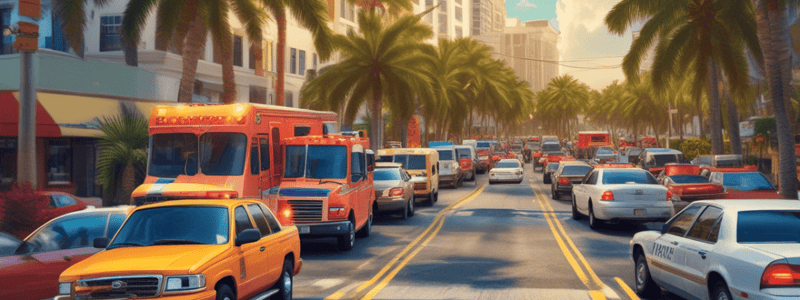Podcast
Questions and Answers
What is the primary purpose of Florida's Move Over Law?
What is the primary purpose of Florida's Move Over Law?
- To ensure smooth traffic flow on multi-lane roadways
- To protect law enforcement officers, emergency workers, and other roadside workers (correct)
- To minimize the impact of roadside construction on traffic flow
- To reduce the risk of rear-end collisions on two-lane roadways
On a multi-lane roadway, what is the proper action when approaching a stationary emergency vehicle with flashing lights?
On a multi-lane roadway, what is the proper action when approaching a stationary emergency vehicle with flashing lights?
- Honk your horn to alert the emergency personnel of your presence
- Slow down to a speed of 20 MPH below the posted speed limit in the lane closest to the emergency vehicle
- Vacate the lane closest to the stationary emergency vehicle and proceed with caution (correct)
- Maintain your speed and position in the lane closest to the emergency vehicle
If unable to change lanes safely when approaching a stationary emergency vehicle on a multi-lane roadway, what should a driver do?
If unable to change lanes safely when approaching a stationary emergency vehicle on a multi-lane roadway, what should a driver do?
- Honk the horn to alert the emergency personnel of their presence
- Maintain the current speed and position in the lane closest to the emergency vehicle
- Slow down to a speed of 20 MPH below the posted speed limit in the lane closest to the emergency vehicle (correct)
- Activate the vehicle's hazard lights and proceed with caution
On a two-lane roadway, when approaching a stationary emergency vehicle with flashing lights, what is the proper action?
On a two-lane roadway, when approaching a stationary emergency vehicle with flashing lights, what is the proper action?
If the posted speed limit on a two-lane roadway is 20 MPH or less, what speed must a driver reduce to when approaching a stationary emergency vehicle?
If the posted speed limit on a two-lane roadway is 20 MPH or less, what speed must a driver reduce to when approaching a stationary emergency vehicle?
When approaching a stationary emergency vehicle on a multi-lane roadway, what should drivers in lanes other than the closest lane be prepared for?
When approaching a stationary emergency vehicle on a multi-lane roadway, what should drivers in lanes other than the closest lane be prepared for?
What is the proper action for motorists, bicyclists, and pedestrians when encountering emergency vehicles with sirens or flashing lights?
What is the proper action for motorists, bicyclists, and pedestrians when encountering emergency vehicles with sirens or flashing lights?
Flashcards are hidden until you start studying




